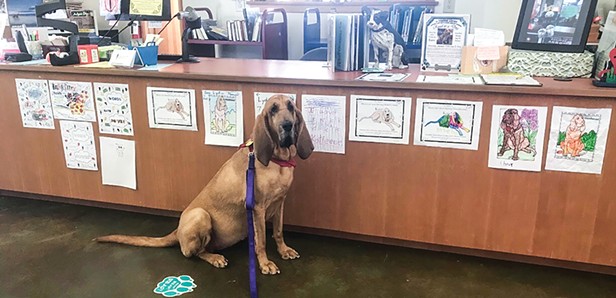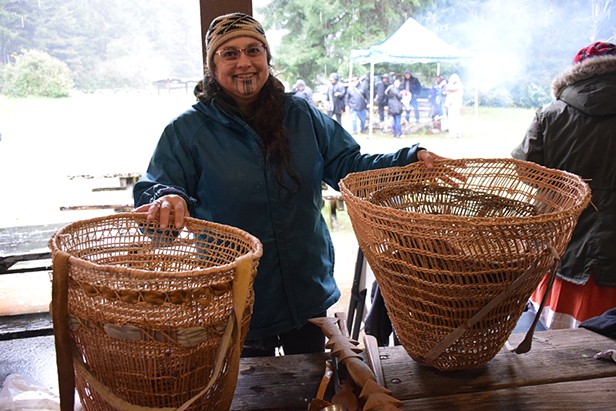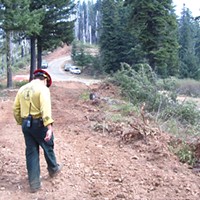Anatomy of a Fire Fight
By Emily Hamann
Photo by Emily Hamann
A strike team (that's five fire engines) leaves the Butler Fire camp to assist on a new fire near Beaver Creek in Hoopa on Aug. 21. Along with help from helicopters from the Corral Complex, they'll have it out before days' end.

Photo by Emily Hamann
FireDAWG is a private company that provides printing and copying services at the sites of disasters, like wildfires. Chelsea Quigley works in the trailer at one of the Butler fire camps.
Photo by Emily Hamann
The Operations yurt is where they decide how to attack the fire. It's full of maps of the fire showing different information.
Photo by Emily Hamann
Just off of Highway 96, a house is still standing in the wreckage of the extinguished Dance Fire.
Photo by Emily Hamann
Butler Fire Public Information Officer Joe Mazzeo photographs the damage done to his rental car by a falling rock.
Photo by Emily Hamann
Every fire camp is equipped with pallets of water and Gatorade, to replenish tired firefighters' electrolytes.
Photo by Emily Hamann
The food served in fire camp is specially formulated to firefighters' nutritional needs. Firefighters burn between 7,000 and 8,000 calories a day working on the fire, and so the meals are always large.
Photo by Emily Hamann
Every day at around 6 a.m. and 6 p.m., all personnel gather around the briefing area to receive the latest updates on the fire, the weather and get their tasks for the day.
Photo by Emily Hamann
Required supplies for going out into the fire zone include: fire resistant shirt and pants, radio, hardhat, gloves and a fire shelter (just in case).
Photo by Emily Hamann
Fire information staff put regular fire updates around town.
Photo by Emily Hamann
The supply area, which has taken over the tennis courts in Veterans Park, has just about everything you'd need to fight a fire.
Photo by Emily Hamann
Medical crews prepare a utility vehicle, so they can navigate the treacherous terrain in case of a medical emergency.
Photo by Emily Hamann
Fire crews and support personnel sleep in tents scattered around the park and sports field.
Photo by Emily Hamann
Fire camp is always connected to the outside world. They even have Wi-Fi.
Photo by Emily Hamann
Shawn Doggar takes a break from supervising Division Whiskey on the fire line.
Photo by Emily Hamann
High on a ridge above Highway 299, crews clear a line to try to stop the Corral Complex.
Photo by Emily Hamann
Fire crews cleared a fire line through the new growth that's filled in since the 1999 Megram Fire.
Photo by Emily Hamann
A 6,000-gallon water tank lies in wait for the fire to rush up the ridge.
Photo by Emily Hamann
Safety officer Kevin Morris of Roseville, near Sacramento, oversees the safety for Division X-ray.
Photo by Emily Hamann
Part of the reason the Corral Complex poses such a challenge is because of all the dead standing fuel left by the Megram Fire. These burnt dead trees are also unstable and could fall on fire crews.
More slideshows
5 images
5 images
6 images
2/20
Photo by Emily Hamann
FireDAWG is a private company that provides printing and copying services at the sites of disasters, like wildfires. Chelsea Quigley works in the trailer at one of the Butler fire camps.
© 2024 North Coast Journal





Comments